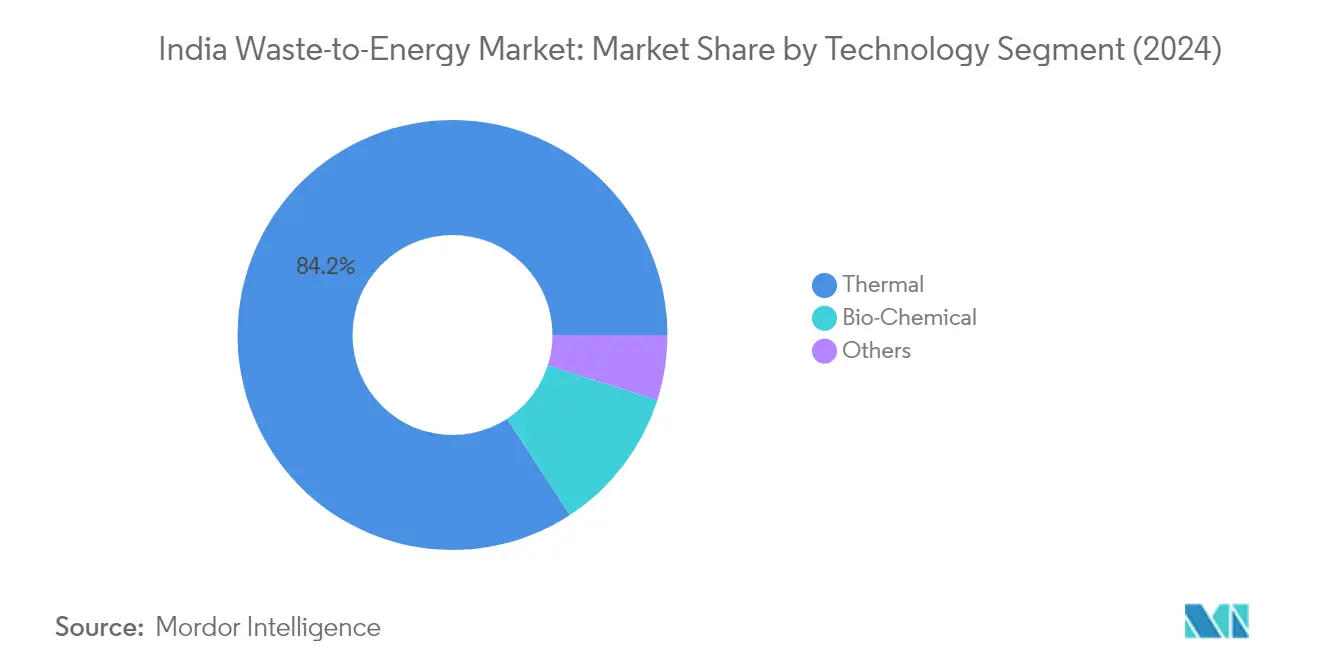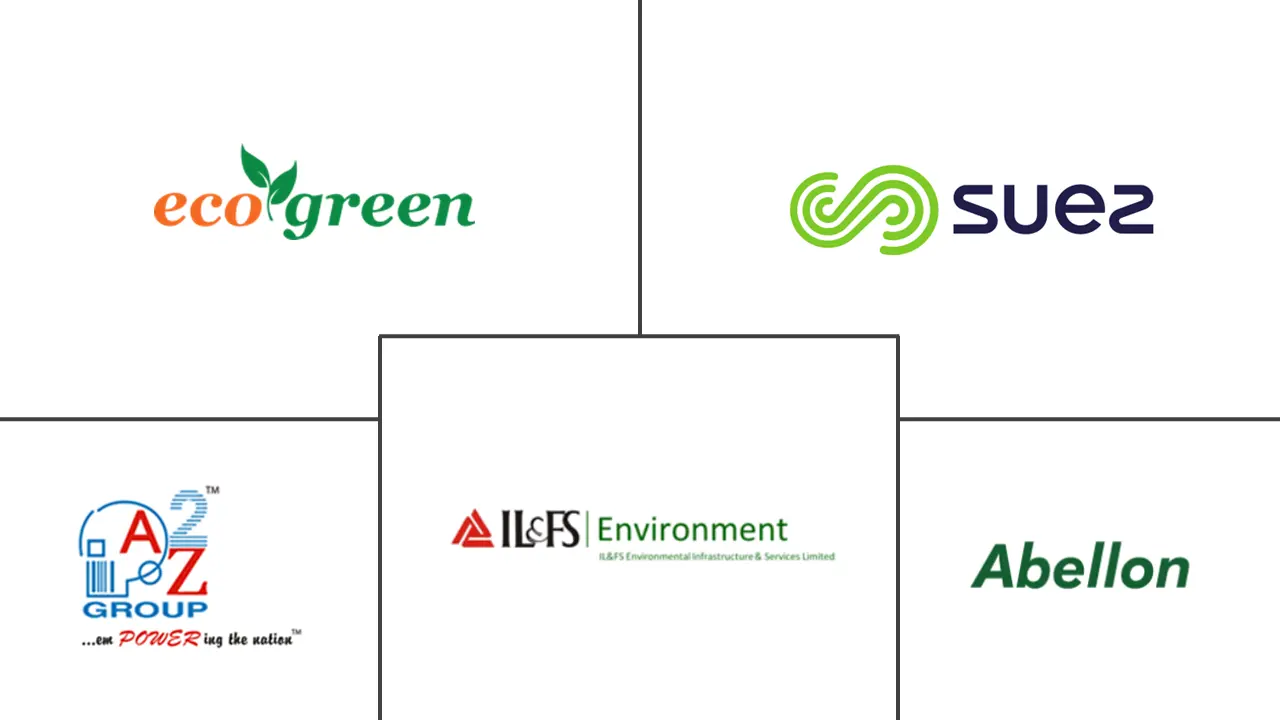
India Waste-to-Energy Market Analysis by Mordor Intelligence
The India Waste-to-Energy Market is expected to register a CAGR of greater than 2.56% during the forecast period.
India's waste-to-energy sector is undergoing significant technological transformation, with a strong focus on emission control and monitoring systems. Most waste-to-energy plants have implemented advanced pollution control technologies, including Flue Gas Treatment (FGT) systems and temperature regulation in combustion chambers. Plants are now equipped with Online Emission Monitoring Systems that enable real-time analysis of emission data, significantly improving environmental compliance. According to NITI Aayog, India has the potential to construct 5.7 gigawatts of waste-to-energy plants using various waste streams, from urban solid waste to agricultural residues.
The industry is witnessing a paradigm shift towards decentralized renewable energy assets, particularly in rural and off-grid communities. As of March 2022, India had established approximately 5.08 million small biogas plants for generating biogas and bio-CNG, demonstrating the growing adoption of smaller-scale waste-to-energy solutions. These modular biogas facilities are proving more economically viable, especially in rural areas, and can be partially funded by local communities, making them an attractive solution for addressing both waste management and energy needs.
Waste characterization and waste processing technologies are evolving to address India's unique waste composition challenges. According to the Central Pollution Control Board, municipal waste typically consists of 40-45% organic fraction and 20-30% inert fraction, with the remainder comprising plastics, paper, and other materials. This has led to innovations in waste processing technologies, including the development of high-rate biomethanation technology based on anaerobic digestion gas lift reactor technology, which has been successfully tested for treating organic solid waste while generating biogas and bio manure.
The recycling and material recovery segment is experiencing significant advancement, with increasing focus on improving utilization rates across different waste streams. According to the International Solid Waste Association (ISWA), material utilization rates have shown promising trends, with plastic utilization reaching 60%, paper at 30%, and metal between 20-25%. The sector has seen notable private sector participation, exemplified by recent developments such as Huhtamaki Foundation's inauguration of its waste recycling plant in Khopoli, Maharashtra, which processes about 1,600 kilograms of post-consumer flexible plastic waste daily, demonstrating growing industrial commitment to waste management solutions.
India Waste-to-Energy Market Trends and Insights
Growing Urban Population and Waste Generation
India's rapidly expanding urban population has created an unprecedented challenge in waste management, particularly in megacities and metropolitan areas with high population densities. The composition of municipal solid waste, comprising 40-45% organic fraction and 20-30% inert fraction, presents both a challenge and an opportunity for waste-to-energy conversion. This substantial organic content, combined with the increasing volume of waste generation in urban areas, provides a consistent feedstock supply for waste-to-energy facilities, driving the market's growth.
The escalating waste management crisis in urban areas, characterized by overflowing landfills and limited space for waste disposal, has necessitated the adoption of more efficient sustainable waste management solutions. Traditional landfills in major cities are rapidly reaching their capacity limits, creating an urgent need for alternative waste disposal methods. This situation has positioned waste-to-energy technologies as a crucial solution for urban waste management, offering the dual benefit of waste volume reduction and energy generation from what would otherwise be unutilized waste material.
Government Support and Initiatives
The Indian government's proactive approach in promoting waste-to-energy projects has become a significant market driver, exemplified by the Ministry of Housing and Urban Affairs' initiatives to expand the sector. As of March 2022, the country hosts approximately 249 operational waste-to-energy plants with an input capacity of 0.074 lakh tonnes per day, demonstrating the government's commitment to developing this sector. Furthermore, the construction of 44 additional waste-to-energy plants, as reported by the Ministry of Housing and Urban Affairs, reflects the strong governmental support for expanding the industry's infrastructure.
The implementation of supportive policies and regulations has created a favorable environment for market growth. For instance, the Indian Ministry of Housing and Urban Affairs' mandate requiring industrial units to replace at least 5% of their fuel requirement with refuse-derived fuel (RDF) has created a guaranteed market for waste-to-energy products. Additionally, various state governments are actively participating in waste-to-energy initiatives, such as Kerala's collaboration with the World Bank and Asian Infrastructure Investment Bank for funding five sanitary landfill projects, demonstrating the multi-level governmental support driving market expansion.
Energy Demand and Environmental Concerns
The growing energy demands of India's expanding economy, coupled with environmental concerns, have positioned waste-to-energy as a viable solution for sustainable energy generation. According to NITI Aayog, India has the potential to construct 5.7 gigawatts of waste-to-energy plants using various waste sources, including urban solid waste, slaughterhouse waste, distillery waste, and farm stubble. This substantial potential, combined with the country's commitment to reducing environmental impact, has made waste-to-energy an attractive option for both energy generation and waste management.
The environmental benefits of waste-to-energy technologies have become increasingly important as India focuses on sustainable development. The sector's ability to significantly reduce waste volume while generating clean energy has made it an essential component of India's environmental strategy. The improvement in waste processing rates from 17.97% in FY2016 to 73% in FY2022 demonstrates the growing adoption of waste processing technologies, including waste-to-energy solutions. This trend is further supported by technological advancements in emission control systems and monitoring technologies, which have helped address environmental concerns and improve the sector's sustainability credentials.
Segment Analysis: Waste Processing - By Technology
Thermal Segment in India Waste-to-Energy Market
The thermal segment dominates the India waste-to-energy market, accounting for approximately 84% of the total market share in 2024. This segment encompasses key technologies including waste incineration, waste pyrolysis, and waste gasification, with incineration being the primary method used for waste processing. The segment's dominance is driven by the increasing adoption of thermal waste treatment technologies across major urban centers in India, supported by government initiatives promoting waste-to-energy projects. Thermal processing offers advantages like significant volume reduction of waste and efficient energy recovery, making it particularly attractive for municipalities dealing with large quantities of municipal solid waste treatment. The segment's growth is further bolstered by technological advancements in emission control systems and improved operational efficiencies of thermal treatment facilities.

Bio-Chemical Segment in India Waste-to-Energy Market
The bio-chemical segment represents a growing opportunity in India's waste-to-energy market, driven by an increasing focus on sustainable waste management practices. This segment utilizes technologies such as anaerobic digestion and fermentation to convert organic waste into biogas and other valuable products. The segment is witnessing increased adoption, particularly in rural and semi-urban areas where organic waste forms a significant portion of the waste stream. The growth is supported by government initiatives promoting decentralized renewable energy assets and the segment's ability to handle wet organic waste effectively. Additionally, the production of bio-fertilizers as a by-product adds to the economic viability of these projects, making them increasingly attractive for both urban and rural implementations.
Remaining Segments in Waste Processing Technology Market
The other technologies segment in the waste-to-energy market includes innovative approaches such as bagasse cogeneration and palletization. These technologies play a complementary role in the overall waste management ecosystem, particularly in specialized applications and specific industrial sectors. Bagasse cogeneration has found significant application in the sugar industry, while palletization and RDF (Refuse Derived Fuel) production are gaining traction in industrial waste management. These technologies offer unique advantages in terms of handling specific waste streams and provide alternative approaches to waste valorization, contributing to the diversification of waste treatment options in India.
Segment Analysis: Disposal Method
Waste Processing Segment in India Waste-to-Energy Market
Waste processing has emerged as the dominant segment in India's waste-to-energy market, commanding approximately 64% of the market share in 2024. This segment encompasses various technologies, including thermal treatment methods like waste incineration, waste pyrolysis, and waste gasification, as well as biochemical processes. The segment's leadership position is driven by increasing adoption of advanced waste processing technologies, particularly in urban areas where municipalities are investing in modern waste treatment facilities. The government's push towards scientific waste management and energy recovery from waste has further strengthened this segment's position. Additionally, the rising focus on reducing landfill dependency and extracting value from waste has led to greater investments in waste processing infrastructure across major Indian cities.
Waste Processing Segment in India Waste-to-Energy Market
The waste processing segment is also experiencing the fastest growth in the market, driven by rapid urbanization and increasing waste generation across Indian cities. This growth is supported by technological advancements in waste processing methods, particularly in thermal and biochemical conversion technologies. The segment's expansion is further accelerated by government initiatives promoting waste-to-energy projects and increasing environmental concerns regarding traditional waste disposal methods. The adoption of advanced technologies like anaerobic digestion and improved incineration systems has enhanced the efficiency of waste processing facilities. Additionally, the growing emphasis on circular economy principles and sustainable waste management practices has created a favorable environment for the segment's growth.
Remaining Segments in Disposal Method
The remaining segments in the waste-to-energy market include landfill and recycling methods. Landfill continues to be a significant disposal method, particularly in smaller cities and rural areas where advanced waste processing infrastructure is limited. However, there is a gradual shift away from landfills due to environmental concerns and land scarcity in urban areas. The recycling segment, while smaller in market share, plays a crucial role in resource recovery and material conservation. This segment is gaining importance due to increasing awareness about sustainable waste management practices and the government's push towards recycling and resource recovery from waste streams.
Competitive Landscape
Top Companies in India Waste-to-Energy Market
The Indian waste-to-energy market is characterized by a mix of domestic and international players focusing on technological advancement and operational excellence. Companies are increasingly investing in innovative waste conversion technology and processing technologies, particularly in thermal treatment and biochemical conversion methods. Strategic partnerships with municipal corporations and government bodies have become crucial for securing long-term waste management contracts. Operational agility is demonstrated through the development of modular and scalable waste processing solutions, allowing companies to adapt to varying waste volumes and compositions. Market leaders are expanding their geographical presence through public-private partnerships while simultaneously diversifying their service offerings across the waste management value chain. The industry is witnessing a growing emphasis on integrated sustainable waste management solutions, combining collection, segregation, processing, and energy generation capabilities.
Market Dominated by Established Infrastructure Players
The competitive landscape is primarily dominated by large infrastructure conglomerates with significant financial capabilities and established relationships with government entities. These players leverage their extensive experience in engineering, procurement, and construction to deliver comprehensive waste management solutions. The market structure shows a moderate level of consolidation, with key players like A2Z Group, JITF Urban Infrastructure, and Ramky Enviro Engineers holding substantial market share. International companies such as Suez Group and Hitachi Zosen Inova have established strong footholds through technology partnerships and joint ventures with local entities.
The market is witnessing increased merger and acquisition activities as companies seek to strengthen their technological capabilities and expand their geographical presence. Large conglomerates are acquiring specialized waste management firms to enhance their service portfolios and gain access to proprietary technologies. The entry of international waste management companies has introduced advanced technologies and operational best practices, elevating the overall industry standards. Regional players are forming strategic alliances to compete with larger entities and maintain their market position in specific geographical areas.
Innovation and Integration Drive Future Success
Success in the waste-to-energy market increasingly depends on technological innovation and the ability to provide integrated solutions. Incumbent players are focusing on developing proprietary technologies for waste segregation and processing, while also investing in smart waste management systems incorporating IoT and automation. Companies are strengthening their position by establishing end-to-end capabilities, from waste collection to energy generation, and developing strong relationships with municipal authorities. The market is seeing a growing emphasis on environmental compliance and sustainability metrics, making it essential for players to invest in clean technologies and efficient processing methods.
For new entrants and emerging players, success lies in identifying niche segments and developing specialized solutions for specific waste streams. Companies are focusing on developing cost-effective and scalable solutions suitable for smaller municipalities and industrial clusters. The regulatory environment is becoming more stringent, with increasing emphasis on environmental compliance and operational efficiency, creating opportunities for technology-focused players. Market participants are also exploring innovative business models, including pay-per-use and revenue-sharing arrangements, to address the high capital investment requirements and operational costs associated with waste-to-energy projects.
India Waste-to-Energy Industry Leaders
-
Suez Group
-
Abellon Clean Energy Ltd
-
Il&fs Environnemental Infrastructure And Services Limited
-
Ecogreen Energy Pvt. Ltd.
-
A2z Group
- *Disclaimer: Major Players sorted in no particular order

Recent Industry Developments
- March 2022: The WASTE-TO-ENERGY Recycling Plant, a flagship project of the Greater Visakhapatnam Municipal Corporation (GVMC), commenced operating at Kapuluppada in Visakhapatnam. The plant generates about 9.90 MW of power per day using one boiler. According to the agreement between Jindal Group and the GVMC, the recycling plant will generate about 15 MW of electricity daily. To generate 15 MW of power, GVMC focused on providing about 1,200 tones of waste per day. The corporation is mulling to transport 260 tones of garbage from Srikakulam, Vizianagaram, and Nellimarla municipalities.
- January 2022: Brihanmumbai Municipal Corporation proposed the construction of a waste-to-energy plant with a capacity of 600 metric tonnes per day capacity, at Mumbai's oldest dumping ground, Deonar, on 12.19 hectares area and at the cost of INR 5.04 billion.
India Waste-to-Energy Market Report Scope
Waste-to-energy is the process of generating energy in the form of electricity and/or heat through the primary treatment of waste or processing of the same into a fuel source. The technology used for this process includes physical, thermal, and biological technologies.
The Indian waste-to-energy market is segmented by technology (thermal (incineration, pyrolysis, and gasification), biochemical, and other technologies) and disposal method (landfill, waste processing, and recycling). The report offers the market size and forecasts in terms of value in USD million.
| Thermal | Incineration |
| Pyrolysis | |
| Gasification | |
| Bio-Chemical | |
| Other Technologies |
| Landfill |
| Waste Processing |
| Recycling |
| Technology | Thermal | Incineration |
| Pyrolysis | ||
| Gasification | ||
| Bio-Chemical | ||
| Other Technologies | ||
| Disposal Method | Landfill | |
| Waste Processing | ||
| Recycling |
Key Questions Answered in the Report
What is the current India Waste-to-Energy Market size?
The India Waste-to-Energy Market is projected to register a CAGR of greater than 2.56% during the forecast period (2025-2030)
Who are the key players in India Waste-to-Energy Market?
Suez Group, Abellon Clean Energy Ltd, Il&fs Environnemental Infrastructure And Services Limited, Ecogreen Energy Pvt. Ltd. and A2z Group are the major companies operating in the India Waste-to-Energy Market.
What years does this India Waste-to-Energy Market cover?
The report covers the India Waste-to-Energy Market historical market size for years: 2019, 2020, 2021, 2022, 2023 and 2024. The report also forecasts the India Waste-to-Energy Market size for years: 2025, 2026, 2027, 2028, 2029 and 2030.
Page last updated on:



